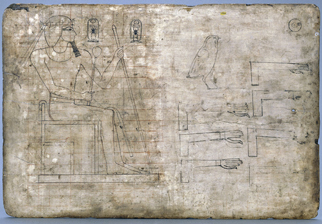4 Designing the decoration
Before the plastered surface could be decorated, however, various decisions had to be taken about the overall design.
It is quite likely some of these decisions would be taken either by, or with the involvement of, the tomb-owner himself. What these decisions might have been, no one now knows. But since the tomb would have been very expensive, accounting for a large proportion of Nebamun’s wealth, it is likely he would have taken some kind of role in deciding the scheme.
Once again it is worth bearing in mind the difficulties of the process. Large sheets of draughtsman’s paper, for example, were not available, let alone the facilities of a modern drawing office. Papyrus sheets may have been used to draw out plans, but these would not have been very large (Figure 10). Small drawings also exist on flakes of stone and ceramic with plane surfaces, known as ‘ostraca’ (Figure 11).


It is unclear how such small designs might have been ‘blown up’ to full size. It is possible there may have been pattern books in use, for some features of the designs were conventionalised. These included the borders as well as motifs. There are also surviving examples of plane surfaces rather like ‘drawing boards’, perhaps the same sort of thing as a table top, onto which a design could have been laid out, and then whitewashed over and re-used for the next one. One such example from the New Kingdom is in the British Museum, though the drawing it retains is an apprentice exercise.
